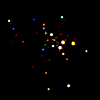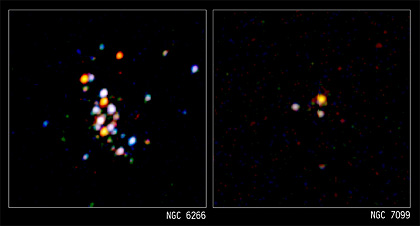X-Ray Binaries In Globular Clusters
Chandra's unique ability to precisely locate and resolve individual X-ray sources in 12 globular clusters in our Galaxy has given astronomers a crucial clue as to the origin of these sources. Two clusters, known as NGC 6266 (or M62) and NGC 7099 (or M30), are shown here.
A globular cluster is a spherical collection of hundreds of thousands and even millions of stars buzzing around each other in a gravitationally bound stellar beehive that is about a hundred light years in diameter. The stars in a globular cluster are often only about a tenth of a light year apart. For comparison, the nearest star to the Sun, Proxima Centauri, is 4.2 light years away.
Most of the point-like sources in these images are binary star systems containing a collapsed star, such as a neutron star or a white dwarf star, that is pulling matter off a normal companion star. While direct, head-on collisions between stars are rare even in these crowded circumstances, close encounters occur and can lead to the formation of binary star systems containing a collapsed star.
The images illustrate a general trend observed for globular clusters. Clusters such as M62 where the stars are packed very closely together and the rate of close encounters is high have more X-ray binaries than those such as M30 in which close encounters occur less often. This is strong evidence that the X-ray binaries in globular clusters are formed by close encounters.
| ||




